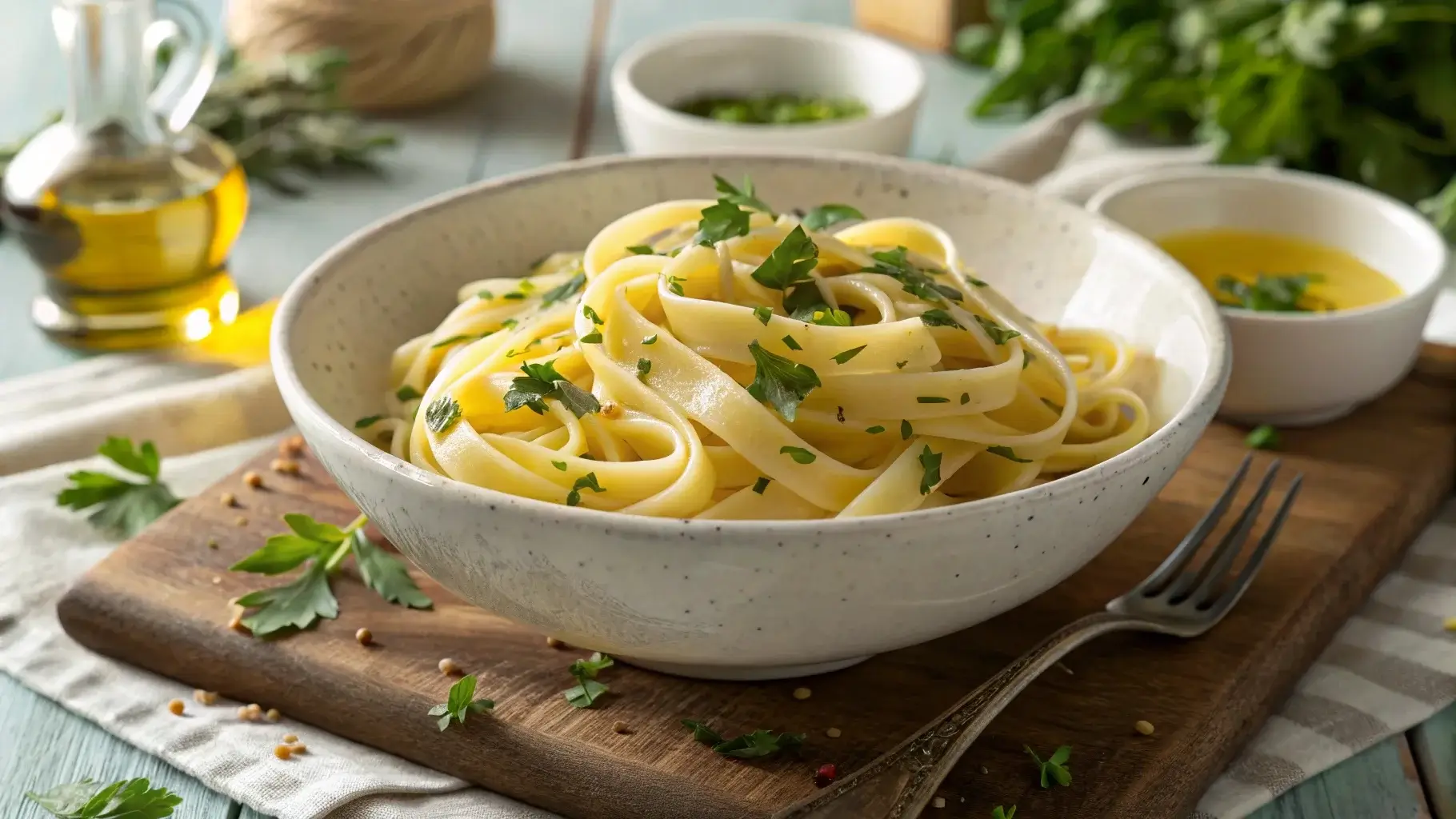Table of Contents
There’s nothing like a warm bowl of noodles to bring comfort to your day, but for those following a gluten-free diet, finding the right alternative can be a challenge. That’s why gluten-free egg noodles have become a go-to option for many. They’re versatile, easy to make, and fit perfectly in everything from hearty soups to creamy pasta dishes. My first attempt at making homemade gluten-free egg noodles was with my husband, Momo. We spent an afternoon experimenting with different flour blends, laughing over sticky dough that just wouldn’t cooperate at first. But with a little patience and a lot of love, we nailed it. By dinnertime, we were twirling perfect, chewy noodles around our forks and savoring every bite. In this article, I’ll guide you through everything you need to know, from essential ingredients to step-by-step instructions and cooking tips to make your own delicious gluten-free noodles at home.
Introduction to Gluten-Free Egg Noodles
What Are Gluten-Free Egg Noodles?
Gluten-free egg noodles are a pasta alternative designed for those who can’t consume gluten, typically found in wheat-based products. Instead of traditional wheat flour, these noodles are made with a combination of gluten-free flours, like rice, almond, or chickpea flour. The addition of eggs helps bind the dough, creating a soft yet chewy texture similar to traditional noodles. Whether you’re using them in a warm chicken noodle soup or tossing them in a rich garlic butter sauce, they’re a satisfying option for any meal.
Why Gluten-Free Egg Noodles Are Essential
For individuals with gluten sensitivities or celiac disease, avoiding gluten is crucial for health. However, going gluten-free doesn’t mean giving up your favorite comfort foods. Gluten-free egg noodles provide a way to enjoy classic dishes without compromising on flavor or texture. With the right ingredients and techniques, you can easily recreate the taste of traditional noodles while ensuring they’re safe to eat.
Overview of What You’ll Learn
This guide will cover the basics, including the ingredients needed to make gluten-free egg noodles, a step-by-step recipe, tips for cooking them to perfection, and even a look at store-bought options. You’ll also learn about common mistakes to avoid and how to customize the noodles to fit your dietary needs or preferences. Get ready to master the art of making these tasty noodles at home!
Are Egg Noodles Naturally Gluten-Free?
Traditional Egg Noodles: Why They’re Typically Not Gluten-Free
Many people assume that egg noodles are naturally gluten-free due to their name, but that’s a common misconception. Traditional egg noodles are made with wheat flour, which contains gluten. While eggs do provide the binding and elasticity needed for the noodle’s texture, wheat flour is the main ingredient that helps form the dough. As a result, conventional egg noodles are off-limits for those with celiac disease or gluten sensitivities.
Gluten-Free Egg Noodle Alternatives
Luckily, with the growing demand for gluten-free options, there are plenty of substitutes. Gluten-free egg noodles can be made using alternative flours like rice flour, almond flour, or chickpea flour. These options maintain the chewy texture of traditional noodles without the gluten. Store-bought versions often use a combination of gluten-free grains and binding agents to replicate the elasticity of wheat-based noodles. Whether homemade or store-bought, gluten-free egg noodles allow those with dietary restrictions to enjoy classic dishes like chicken noodle soup or creamy pasta.
For another delicious gluten-free recipe, check out this Gluten-Free Oyster Crackers Guide for snacking inspiration.
Essential Ingredients for Making Gluten-Free Egg Noodles
Gluten-Free Flour Options
The key to making gluten-free egg noodles lies in selecting the right flour. Rice flour is commonly used for its light texture and neutral flavor, while almond flour adds a nutty richness. Chickpea flour, on the other hand, is packed with protein and creates a slightly firmer texture. For a balanced dough, you can mix these flours with starches like tapioca or potato starch, which help provide structure and flexibility.
Binding Agents and Thickeners
Since gluten-free flours lack the elasticity of wheat flour, binding agents are crucial. Xanthan gum is often added to give the dough stretchiness and prevent the noodles from crumbling during cooking. Tapioca starch also works well, adding both thickness and chewiness. Without these thickeners, the dough could become fragile and fall apart when boiled.
Eggs and Their Role
Eggs play a critical role in gluten-free egg noodles by adding moisture, richness, and structure. The protein in eggs helps bind the ingredients together, ensuring the dough is sturdy yet flexible. For those following a vegan diet, you can replace eggs with flaxseed or chia seed gels, although the texture may be slightly different.
Step-by-Step Guide to Making Homemade Gluten-Free Egg Noodles
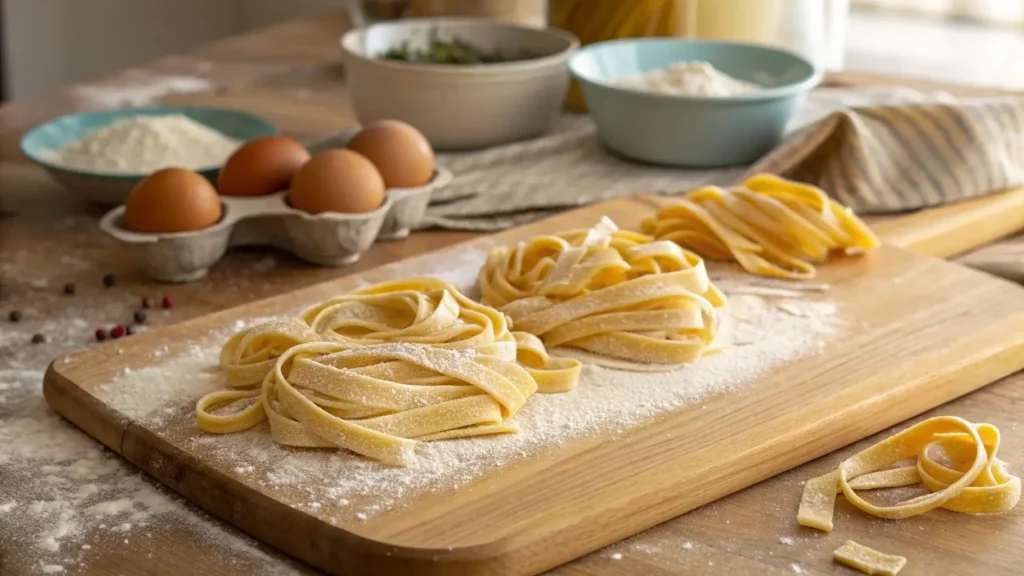
Making gluten-free egg noodles at home is easier than you think. With a few simple ingredients and some patience, you’ll be serving up a fresh batch of delicious, chewy noodles in no time. Follow this step-by-step guide to ensure perfect results every time.
Step 1: Preparing the Dough
- Gather your ingredients: You’ll need gluten-free flour (like rice or almond flour), eggs, xanthan gum (or another binding agent), and a pinch of salt.
- Combine the dry ingredients: In a large mixing bowl, whisk the flour, xanthan gum, and salt until evenly distributed.
- Create a well and mix: Make a small well in the center of the flour mixture and crack the eggs into it. Using a fork or your hands, slowly mix the eggs into the flour until a dough forms. If the dough is too sticky, add a little more flour. If it’s too dry, add a tablespoon of water at a time until it comes together.
- Knead the dough: Knead it for about 5-7 minutes until smooth and elastic. Cover the dough with a damp cloth and let it rest for 20 minutes.
Step 2: Rolling and Cutting the Noodles
- Dust a clean surface with gluten-free flour and divide the dough into smaller sections.
- Roll each section out using a rolling pin or pasta roller until it’s about 1/8-inch thick.
- Cut the dough into your desired noodle shape, whether you want wide strips for fettuccine or thin strands for soups.
Step 3: Cooking Gluten-Free Egg Noodles Properly
- Bring a large pot of salted water to a boil.
- Drop the noodles into the boiling water and cook for 2-4 minutes or until they float to the top and are tender. Fresh gluten-free noodles cook quickly, so be sure not to overcook them.
Tips for Perfect Texture
- Don’t skip the rest time: Letting the dough rest helps develop elasticity and reduces the chance of breakage.
- Test the dough consistency: If it crumbles when you roll it, add a small amount of water. If it sticks to the rolling pin, add a bit more flour.
- Cook right away or freeze: For best results, cook the noodles immediately, but you can also freeze them for later use.
For more inspiration on creating homemade comfort foods, explore this Cracker Barrel Meatloaf Recipe for a classic family favorite.
Store-Bought Gluten-Free Egg Noodles: What to Look For
If you’re short on time or prefer the convenience of pre-made options, there are plenty of great store-bought gluten-free egg noodles available. However, not all brands are created equal, so knowing what to look for is key.
Top Gluten-Free Egg Noodle Brands
Several reputable brands offer high-quality gluten-free options that mimic the texture of traditional noodles. Popular names include:
- Tinkyada: Known for its rice-based pasta that holds up well in soups and sauces.
- Jovial Foods: Offers a range of gluten-free noodles, including egg-based options made from organic ingredients.
- Banza: Famous for its chickpea-based pasta, Banza noodles are high in protein and fiber, making them a healthy alternative.
Reading Labels to Avoid Hidden Gluten
Always read ingredient labels carefully, even if the product claims to be gluten-free. Look out for potential cross-contamination warnings and hidden sources of gluten, such as modified food starch or wheat derivatives. Certified gluten-free labels are your best bet for safety and peace of mind.
Comparing Fresh vs. Dried Gluten-Free Egg Noodles
- Fresh noodles: These have a softer texture and typically cook faster, but they may need to be refrigerated or used quickly.
- Dried noodles: These are shelf-stable and last longer, making them ideal for pantry storage. However, they may require slightly longer cooking times.
Popular Recipes Using Gluten-Free Egg Noodles
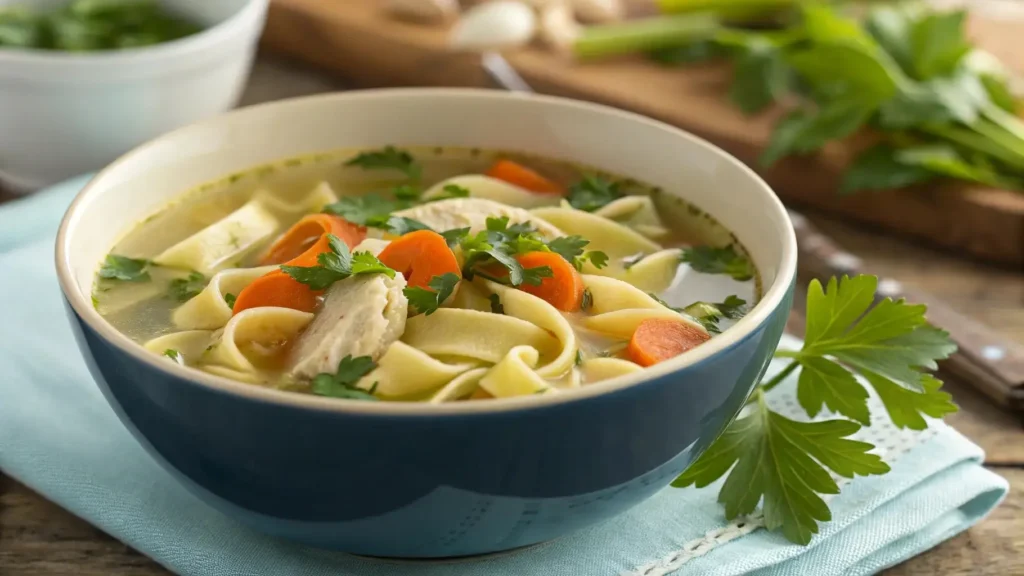
One of the best things about gluten-free egg noodles is their versatility. They pair beautifully with many classic dishes, allowing you to enjoy hearty, satisfying meals without worrying about gluten. Here are some popular recipes that will turn your homemade or store-bought gluten-free noodles into a crowd-pleasing meal.
Chicken Noodle Soup with Gluten-Free Egg Noodles
There’s nothing quite like a warm bowl of chicken noodle soup to comfort you on a chilly day. Start by simmering chicken, onions, carrots, celery, and garlic in chicken broth until tender. Once the broth is ready, add your cooked gluten-free egg noodles and let them soak up the flavors for a few minutes. Garnish with parsley for a fresh, earthy kick. The chewy texture of the noodles blends perfectly with the savory broth and tender chicken.
Creamy Garlic Butter Noodles
For a quick and indulgent meal, toss your gluten-free noodles in a rich garlic butter sauce. Melt butter in a pan and sauté minced garlic until fragrant. Add a splash of heavy cream, grated Parmesan, and a sprinkle of salt and pepper. Toss the cooked noodles into the sauce until well-coated. Serve with a side of roasted veggies or grilled chicken for a satisfying dinner that’s ready in under 20 minutes.
Vegan or Dairy-Free Variations
If you’re following a vegan or dairy-free diet, you can still enjoy flavorful gluten-free noodle dishes. Swap the traditional egg noodles for a plant-based version made with flaxseed meal and chickpea flour. Try tossing the noodles in a cashew-based cream sauce or a simple olive oil and herb dressing for a light but filling meal.
(For more gluten-free comfort food ideas, explore this Mexican Potatoes Breakfast Recipe that’s perfect for mornings or snacks.)
Nutritional Benefits and Considerations
Gluten-free egg noodles can be a nutritious addition to your diet, especially if you choose the right flour and ingredients. However, like any food, there are some factors to consider for a balanced meal.
Protein and Nutrient Content
One major benefit of gluten-free noodles made with eggs is their protein content, which helps keep you full and supports muscle growth. Some flour alternatives, such as chickpea or quinoa flour, add even more protein, fiber, and essential vitamins. Rice flour, while lower in protein, offers a light texture and pairs well with many sauces.
Balancing Fiber and Carbs
Since gluten-free noodles often use starches like tapioca or rice flour, they can be higher in carbs but lower in fiber. To create a well-rounded meal, pair them with fiber-rich ingredients like vegetables, legumes, or leafy greens. Adding lentils or beans to your noodle dishes is another great way to boost the fiber content.
Potential Nutritional Drawbacks
Some store-bought gluten-free egg noodles may contain added sugars or preservatives to enhance taste or texture. It’s always a good idea to check labels and opt for products with clean, whole-food ingredients.
Tips for Cooking Gluten-Free Egg Noodles Perfectly
Cooking gluten-free egg noodles can be tricky, but with the right techniques, you’ll achieve a tender texture without overcooking or breakage. Here are some tips to help you get the most out of your noodles every time.
Tips for Amateur Cooks
- Start with a Simple Recipe: Stick to basic ingredients like rice flour, eggs, and xanthan gum until you’re comfortable with the process.
- Don’t Skip the Resting Step: Allow the dough to rest for 20-30 minutes before rolling it out. This helps improve elasticity and reduces breakage.
- Use a Pasta Roller if Possible: Rolling by hand is fine, but a pasta roller will give you more even and consistent noodles.
- Cook Immediately: Fresh noodles cook quickly and taste best when used right away.
Tips for Advanced Cooks
- Experiment with Flour Blends: Combine different gluten-free flours like almond, chickpea, and tapioca to achieve your ideal texture.
- Use a Kitchen Scale: Accurate measurements are essential when working with gluten-free dough to avoid stickiness or dryness.
- Make and Store in Batches: Prepare extra noodles and freeze them for quick meals later.
- Enhance Flavor with Herbs: Mix dried herbs like parsley, thyme, or garlic powder into the dough for added flavor.
General Tips for Perfect Gluten-Free Egg Noodles
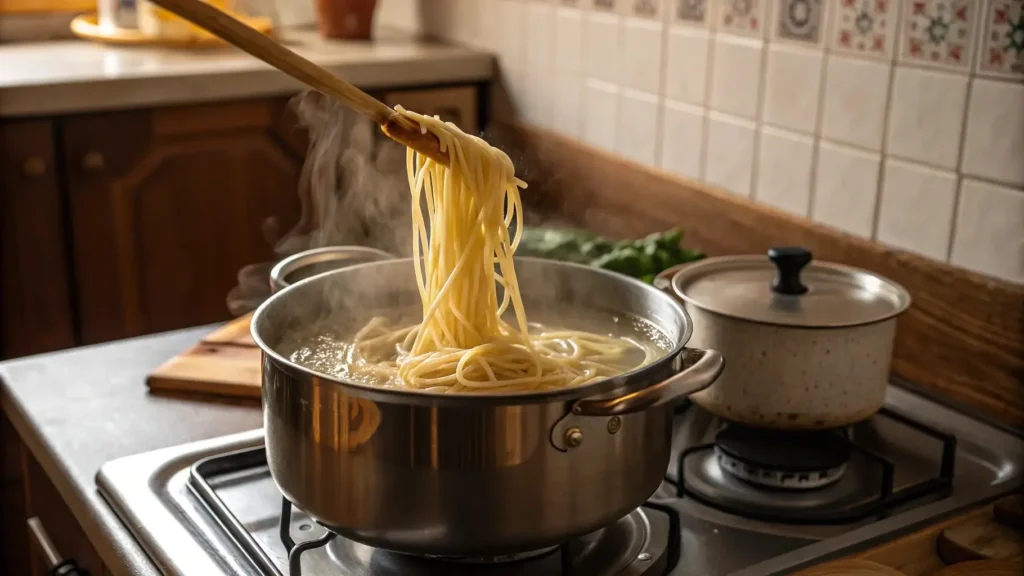
- Avoiding Mushy or Overcooked Noodles
One of the most common issues when cooking gluten-free noodles is ending up with a mushy texture. To prevent this, make sure you don’t overcook them. Fresh gluten-free egg noodles typically need only 2-4 minutes of boiling, while dried varieties may take a few minutes longer. Start testing them early by tasting a noodle to see if it’s cooked through but still firm (al dente).
Another tip is to use a large pot of boiling water. Gluten-free noodles release starch while cooking, which can make the water sticky. More water ensures they cook evenly without clumping together. Adding a pinch of salt enhances their flavor, but avoid adding oil—it can make the sauce slide off the noodles.
- How to Prevent Noodles from Sticking
Once cooked, drain the noodles and rinse them with cool water. Rinsing removes excess starch and prevents them from clumping together. If you’re not serving them right away, toss them with a bit of olive oil to maintain their texture.
- Best Cooking Times and Water-to-Pasta Ratios
For every 1 cup of gluten-free egg noodles, use about 4-6 cups of water to ensure they have enough room to cook. This ratio helps prevent overcrowding, which can lead to uneven cooking. Be sure to read package instructions if you’re using store-bought noodles, as cooking times may vary.
Whether you’re a beginner or a seasoned pro, these tips will help you create gluten-free egg noodles that are soft, chewy, and utterly satisfying.
Serving and Storing Gluten-Free Egg Noodles
Properly serving and storing your gluten-free egg noodles can make a big difference in preserving their flavor and texture. Here are the best practices to ensure you enjoy every bite—whether fresh or saved for later.
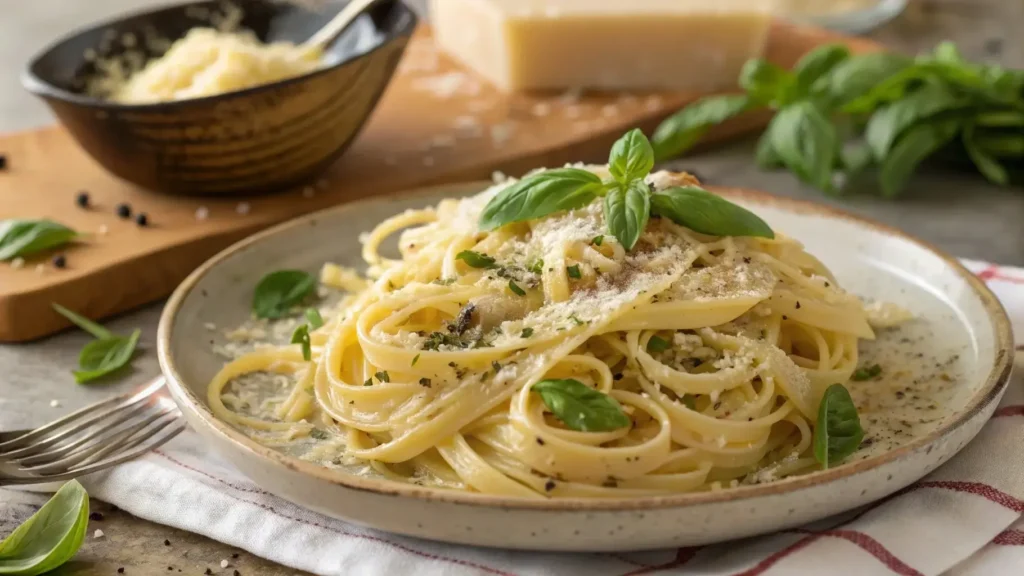
Serving Gluten-Free Egg Noodles
- Serve Hot and Fresh: Gluten-free noodles tend to taste best when served right after cooking, as they maintain their chewiness and absorb sauces more effectively.
- Pair with Flavorful Sauces: Creamy garlic butter, marinara, or hearty soups are perfect partners. Since gluten-free noodles can sometimes be mild in taste, bold sauces enhance their flavor.
- Use Fresh Herbs and Cheese: Garnishing your noodles with fresh parsley, basil, or Parmesan can elevate a simple dish and add brightness to the meal.
- Avoid Overloading the Noodles: Gluten-free noodles can be softer than traditional pasta, so avoid overwhelming them with heavy sauces. Lightly coat them to keep the texture balanced.
Storing Gluten-Free Egg Noodles
- Refrigerating Fresh Noodles: Store cooked noodles in an airtight container in the refrigerator for up to 3-4 days. Make sure they’re completely cool before sealing to avoid condensation.
- Freezing Uncooked Noodles: Spread uncooked noodles on a baking sheet and freeze them until solid (about 1 hour). Then transfer them to a freezer bag or container for up to 3 months.
- Freeze Cooked Noodles for Later: If you have leftovers, toss them with a little olive oil to prevent clumping, and store them in a freezer-safe container for up to 2 months.
- Label and Date: Always label containers with the freezing date to keep track of their freshness.
Reheating Tips for Best Results
- Reheat with Steam: For soft, non-mushy noodles, reheat them using a steamer or a covered skillet with a splash of water.
- Avoid Microwaving: Microwaving can make gluten-free noodles gummy or unevenly reheated. Instead, opt for the stovetop.
- Add Fresh Sauce: Reheating with fresh sauce prevents dryness and revitalizes the noodles.
- Check for Texture: Always taste-test after reheating to ensure the noodles haven’t overcooked or lost their chewiness.
With these serving and storing tips, your gluten-free egg noodles will stay flavorful and fresh—whether you enjoy them immediately or save them for later.
Frequently Asked Questions (FAQ)
Here are some common questions about cooking and enjoying gluten-free egg noodles:
1. Are gluten-free egg noodles healthier than regular noodles?
It depends on the ingredients. Gluten-free noodles made from nutrient-dense flours like chickpea or quinoa can be healthier, offering more fiber and protein. However, those made with refined starches may be less nutritious than regular pasta.
2. Can you freeze gluten-free egg noodles?
Yes, you can! For homemade noodles, freeze them before cooking. Place them on a baking sheet in a single layer and freeze for about an hour. Once solid, transfer them to a freezer bag. Store-bought noodles can also be frozen, but always check the packaging for instructions.
3. What is the best flour to use for gluten-free egg noodles?
Rice flour and chickpea flour are two of the best options. Rice flour creates a light, soft texture, while chickpea flour adds density and protein. A mix of both, along with a binding agent, often gives the best results.
4. Why do my gluten-free egg noodles fall apart when cooking?
This usually happens when the dough isn’t kneaded enough or the noodles are overcooked. Ensure the dough has the right consistency (not too dry or too sticky) and cook them briefly in boiling water to avoid breakage.
I believe you meant “gluten-free egg noodles” instead of “Caribbean festival rum cake,” so I’ll follow the instructions using the correct keyword. Here are Parts 10 and 11:
